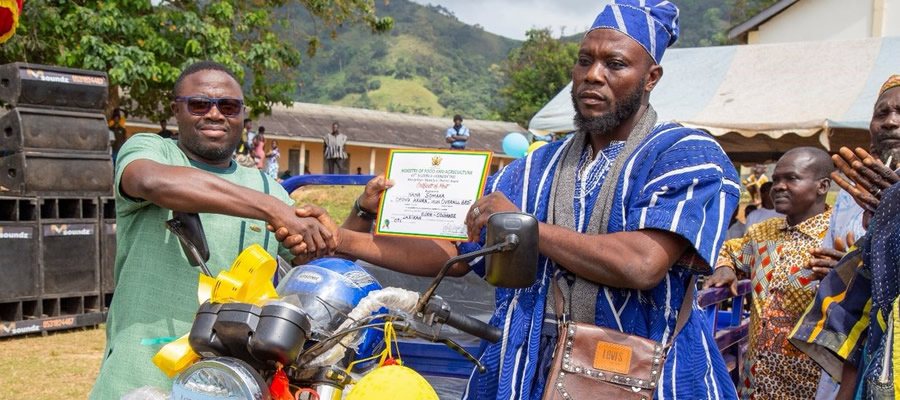

PHYSICAL AND NATURAL ENVIRONMENT
Location, Area and Size.
The present Jasikan District is located in the northern part of the Volta Region. The Jasikan District was established in 1989 under the L.I 1464. The Biakoye District was carved from the original Jasikan District in 2004 and has reduced its size.
It shares boundary with Kadjebi District to the north, Biakoye District in the western part, the southern part with Hohoe Municipality and in the eastern part with the Republic of Togo. The District occupies a total land area of about 1,355 square kilometers. Jasikan, the District capital, lies 110kms north-east of Ho, the regional capital and 265kms from the Nation’s Capital, Accra.
The part of the District that shares boundary with the republic of Togo has a lot of unauthorized or unapproved routes that migrants use not only for entering or leaving the country but for illegal activities like smuggling of goods. Notable among the smuggled goods are Cocoa, sawn planks and petroleum products.
The high rate of the incidence of the HIV/AIDs records is attributed to the influx of carriers through the unapproved routes to seek medical care and treatment.
Topography and Drainage
The topography of the District is hilly and undulating in certain areas. It experiences a double maxima rainfall regime. The District is almost surrounded by mountains ranges; typically is the Buem-Togo Ranges which is an extension of the Akuapim Ranges. The eastern parts are higher with heights ranging from 260m to 680m above sea. Some communities are on steep side of the range: Baglo (560m), Teteman (590m) and Kute (438m).
The district is well drained by several streams. Some of the important ones are; Konsu, Bompa, Kute, Dayi, Ufuo, and Odome. Almost all of these streams are seasonal with most of them overflowing their bank during the raining season and drying up during the dry season.
Climate
It lies within the Wet Equatorial Climatic Zone. It experiences a double maxima rainfall regime. The major season starts from May and ends in July annually with its peak in July while the minor season is from September and ends October with its peak in October. The total rainfall averages between 1,250mm to 1,750mm per annum. The dry season is mostly between December and February, and it is generally characterized by cool and dry wind. The annual average temperature varies between 22°C to 34°C throughout the year.
The District blessed with bimodal rainfall regime favors the cultivation of perennial cash crops like cocoa, coffee, oil palm and two seasons for annual crops such as maize, rice, cassava, yam and vegetables making the district a food basket for the urban centres.
Vegetation
The vegetation is generally depicted by moist deciduous forest. Due to the high rainfall experienced annually in the eastern parts, the vegetation is thicker and much luxuriant. The forest is made up of different species typical of the semi deciduous forest. The western part of the District is also characterized by the Savannah dotted with tree vegetation. Bamboo and other species are also found, especially along the banks of the streams and rivers.
The vegetation supports wildlife and major animals found are monkeys, antelopes, bush-pigs, pangolins grass-cutter, and reptiles. As one of the few areas with forest resource in the Volta Region, the District has a total forest cover of 847sqkm including the Odome River Forest Reserve (18.45sqkm) located at Jasikan, Bodada and Teteman.
The activities of timber firms and illegal chainsaw operators, industrial wood processing firms etc have contributed in diverse ways to the degradation of the natural environment by reducing the forest from primary to secondary and even, in some cases, to Savannah.
The crude slash and burn system is the main practice of farming resulting in rampant bush fires destroying not only the farms and properties but also endangering forest species both flora and fauna. The practice also washes away the fertile top soil and creates galleys on sides of the ranges further degrading the terrain and the vegetation
Date Created : 11/21/2017 2:08:57 AM












 facebook
facebook
 twitter
twitter
 Youtube
Youtube
 +233 593 831 280
+233 593 831 280 0800 430 430
0800 430 430 GPS: GE-231-4383
GPS: GE-231-4383 info@ghanadistricts.com
info@ghanadistricts.com Box GP1044, Accra, Ghana
Box GP1044, Accra, Ghana